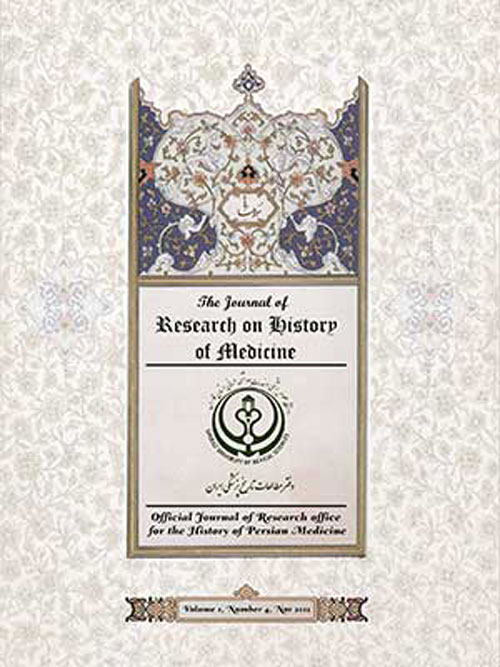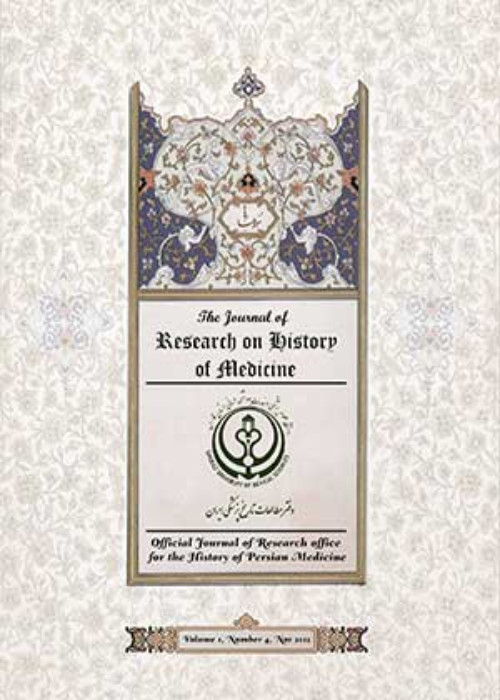فهرست مطالب

Journal of Research on History of Medicine
Volume:11 Issue: 2, May 2022
- تاریخ انتشار: 1401/03/15
- تعداد عناوین: 8
-
-
Pages 75-94
Optimal health care depends on facilities and conditions, such as equipment, medicine and specialized personnel, such as doctors and nurses. Concerning medicine, though briefly, one may find some information, there is scarce information regarding nursing services. It is common knowledge that one main reason for the patient’s recovery and health is how they are cared for. As a profession in Iran, nursing training officially dates back to the late Qajar period. During this period, by opening schools, religious missionaries attempted to educate and train nurses, positively affecting the health status and attitude of the people.Since the Pahlavi era, the government made an effort to open nursing schools which led to the development of the education and training of specialized nurses. The present study intends to deal with the formation of nursing schools and their performance, as well as the measures taken in the Pahlavi period in this regard in Iran, especially in Isfahan. It seems that although public schools and charity organizations have taken various progressive measures in this direction, they, for various reasons, failed to train enough nurses to meet the needs of medical centers. On the other hand, in the Pahlavi II period, charities took the largest share in the training of nurses.
Keywords: School of Nursing, Health, Charity, Pahlavi II, Iran, Isfahan -
Pages 95-104
As a comprehensive and dynamic school, traditional Persian medicine is a collection of theoretical and practical sciences that Iranian scholars have used in different centuries to prevent and treat diseases and maintain health.Persian medical books refer to the benefits of Khadab and its preventive and therapeutic recommendations. One of the leading physicians is the Hakim Seyyed Isma’il Jurjani, who has discussed the effective combination of products in making Khadab and talks about the effects of Khadab on the beauty, health and strong hair. The use of Khadab is an ancient form of treatment in Iran. In fact, the employment of Khadab is a perfectly natural process used to improve skin and hair health and heal ailments. This study examines the prescriptions and combinations related to the types of Khadab and Hakim Seyyed Isma’il Jurjani’s recommendation on Khadab in Persian medicine. According to Hakim Jurjani, Khadabs are classified into several categories: those that turn hair into black, those that turn hair into red, tan or gold, and those that whiten hair.
Keywords: Khadab, Health, Beauty, Hair Strength, Traditional medicine, Persian medicine, Seyyed Isma’il Jurjani -
Pages 105-114Persian Medicine (PM) is a holistic medical system with a unique theoretical base and practical knowledge. Considering its different paradigm and background philosophy compared to conventional medicine, understanding its fundamental principles is necessary for more accurate and efficient clinical practice. One of its fundamental theories is the concept of “Takhalkhol (porosity) and Takasof (condensity)” which has a significant impact on medical practice. This critical issue has been investigated in recent studies to evaluate the density of the body organs as a diagnostic tool. Despite its importance, no distinct section of the leading Persian Medicine sources has been dedicated to elaborating this basic concept. In this study, we have presented this crucial concept based on PM sources and current literature to reveal its clinical relevance in the realm of its clinical relevance in diagnosis and disease management. The relation between porosity and condensity and other issues such as body composition, Mizaj (temperament), and nutrition has been discussed.Keywords: Porosity, Elasticity, Temperament, Persian medicine, Integrative Medicine, Nutrition
-
Pages 115-128While there exists a rich history on anti-malarial drugs and quinine, in particular, the attention of scholars has not reflected the nexuses between the Second World War, quinine shortage and missionaries in the Gold Coast. In contemporary discourses on malaria, less information exists on the historical role of quinine; how the Second World War affected the political economy of quinine and how its consequence impacted missionaries in the Gold Coast. The current contribution gleaned data from a compendium of government records, letters, circulars and reports from the Public Records and Archive Administration in Kumase to discuss the relationship and politics of quinine shortage and missionaries on the Gold Coast between 1939 and 1943. Since its introduction into Western medicine, quinine has been an effective remedy for malaria across the world. However, during the Second World War, the Japanese and German occupation of the Islands of Java troubled the political economy of the distribution of quinine. In response, the colonial administration called for the use of alternative remedies such as quinicrine and mepacrine against malaria in the Gold Coast. From the study, it was realized that the politicization of quinine shortage and related questions reduced the status of missionaries to ordinary citizens who were instructed to acquire their medical supplies in the same manner as the general public.Keywords: Second World War, Quinine, Missionaries, Gold Coast, Malaria, Politics
-
Pages 129-134Human beings and their storytelling mind, sometimes, through imagination and exaggeration, move beyond the obvious signs of an event and its consequences, completely removing or devoiding it of its original meaning, dissociating it from daily life, and turning it into a tool to justify their attitudes and beliefs. One of the bitterest examples of this, in human history, is about the way the story of the prophet Job and the cause of his suffering and illness, along with its treatment, have been reported. Throughout history, most related interpretations have been based on the Torah’s outlooks and writings, resulting in changing the main message of the prophet Job’s story and life.Keywords: Job, Torah, Quran, Suffering, Patience, Hydrotherapy, Attitude


